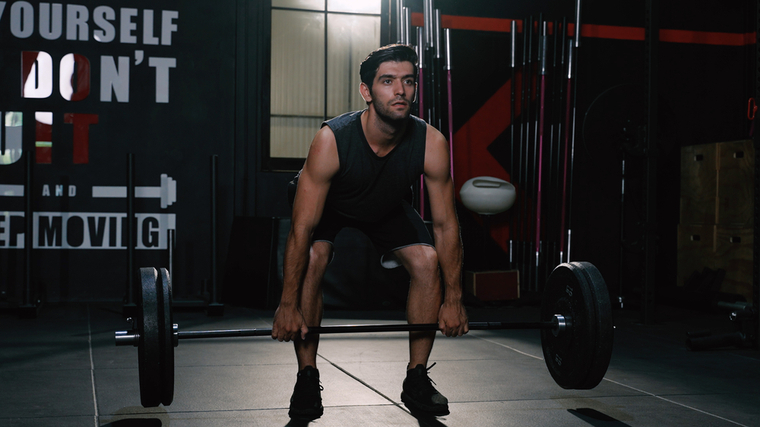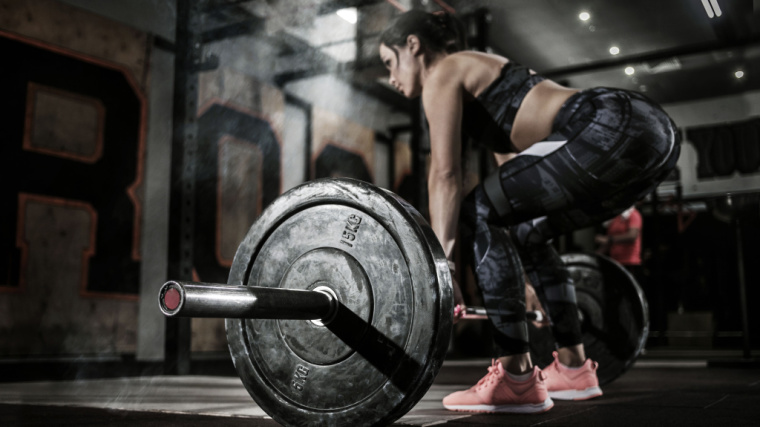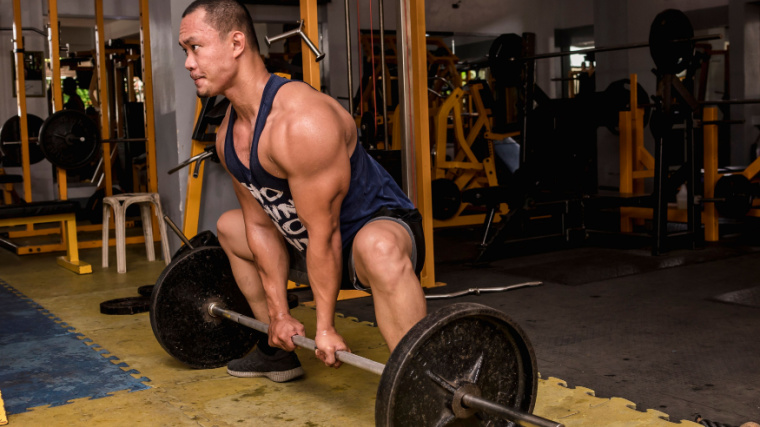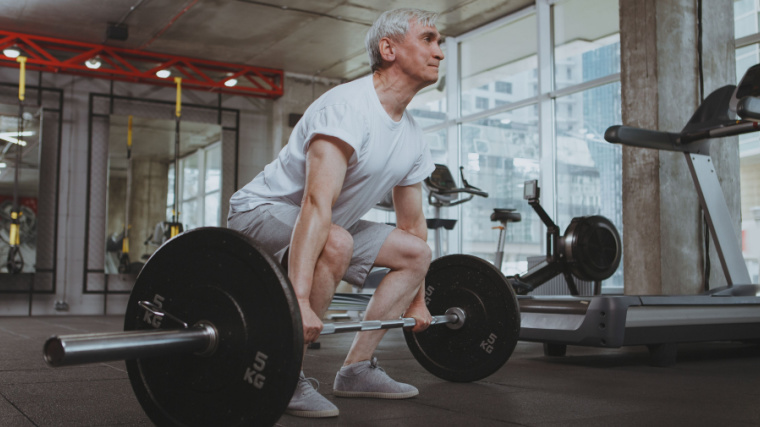Originally Posted At: https://breakingmuscle.com/feed/rss
The classic barbell deadlift might be the most primal and instinctive movement around. “See that weight on the ground? Betcha can’t pick it up. Go try.” While there’s something to be said for brute-forcing your way to a successful lift, a bit of technique can shift the odds in your favor, not to mention making a self-induced injury less likely.

Fundamentally, there are two basic variations of barbell deadlift. There’s the “classic” conventional deadlift performed with a relatively close stance, often considered the standard and most widely used deadlift. There’s also the sumo deadlift, done with its eye-catching wide stance, that’s unfortunately and unjustifiably become considered “a cheater’s exercise” in recent years.
Here’s a closer look that will let you make a fully informed programming choice based on facts and function, not online fitness memes.
Conventional Deadlift and Sumo Deadlift
- Exercise Differences
- Exercise Similarities
- Technique Differences
- How to Deadlift
- How to Sumo Deadlift
- Programming the Right Deadlift for Your Body and Goal
Deadlift and Sumo Deadlift Differences
While the key differences between the deadlift and the sumo deadlift may seem fairly apparent just by watching the exercises being performed, there’s a bit more involved than meets the eye. The movements are more different than just their foot position.
Body Position
The conventional stance deadlift is often performed with a nearly hip-width stance which allows, and actually requires, a significant hip hinge to reach the barbell. This bent-forward position brings your upper body to a moderate angle and puts your glutes, hamstrings, and lower back muscles in a stronger mechanical position to lift the weight.
The sumo deadlift, in contrast, is primarily defined by a wider foot position, well-outside shoulder-width. This, combined with a more outward-angled foot, involves relatively less hip hinge and allows a more upright upper torso position.
This wide stance and upright torso lead to significantly greater activation of the leg muscles, including the quads (front of the thigh), along with less strain on the lumbar (lower back) muscles. (1)
Muscle Recruitment
The conventional deadlift stretches and recruits the hamstrings and glutes because your upper body is angled forward to a greater degree with your legs slightly bent. Your lower back also works to maintain a stiff spine position as you transfer power from your hands through your shoulders to your hips and legs.

This makes your entire posterior chain (lower back, glutes, and hamstrings) the primary muscles worked during the exercise. However, because your hands are grabbing the bar at roughly shoulder-width, your upper back is also recruited to stabilize and support the weight.
During the sumo deadlift, your entire leg muscles (including your quadriceps) are the primary drivers to move the weight. The wide stance and angled foot position also recruits your inner thighs (adductor muscles). Because your upper body is more upright than angled, and your hands are in a close-grip (often hip-width), your upper and lower back muscles are not recruited as much as with the conventional stance.
Lower Back Stress
The deadlift exercise, in general, has a widespread reputation for being “bad for your back.” While that issue is more related to general technique and programming, the conventional deadlift does place a greater strain on the lower back muscles due to the upper body position when lifting the weight.
Some lifters tend to perform the lift with a rounded back, which is an avoidable high-risk mistake. This is also more common with a conventional stance when lifters focus more on “bending forward” to grab the bar instead of hinging their hips back.
The sumo stance is much less stressful on the lower back muscles because it allows you to perform the deadlift with a more vertical upper body. This puts your entire core (abs and lower back) in a stronger and more stable position, less likely to round and more likely to achieve a fully braced position.
Deadlift and Sumo Deadlift Similarities
Both deadlift variations follow a “bend down and lift the weight”- template. In that vein, they overlap in several aspects despite the differences in their technical details. Here’s how you know the exercises are different branches of the same tree.
Concentric Emphasis
Unlike many other exercises, like the squat or bench press for example, deadlifts begin each repetition with the concentric (lifting) phase. This simply means that your muscles are stretched before being placed under load, rather than beginning each repetition with the muscles in contraction. Starting pull-ups from the bottom hanging position would be another example of this type of concentric-focused movement.
By emphasizing the concentric phase, you can increase muscle activation. (2) This is one reason why many lifters are seen “dropping” the barbell from the deadlift lockout position. Emphasizing the concentric also helps to improve power output compared to focusing on the eccentric (lowering phase). (3) This explains why strength athletes like competitive powerlifters and Olympic weightlifters de-emphasize the eccentric portion of many movements.
Deadlift stance doesn’t affect the concentric-focus of the lift because, in both instances, the weight begins on the floor at a dead-stop (hence the name “dead” lift).
Total-Body Development
Even though the specific muscle recruitment will vary between the conventional and sumo deadlift, both movements require coordination between the muscles of the upper and lower body.

You’re driving through the floor with your feet and legs, and transferring that force through your core and back, across your shoulders, through your straight arms, and into your hands grabbing the weight. The deadlift is a total-body exercise, even though it typically focuses on the lower body.
Full-body exercises like the deadlift are a critical staple for beginning lifters establishing a base of muscle and strength, as well as experienced lifters looking to train with efficiency.
Key Technique Differences
The deadlift and sumo deadlift involve specific technique adaptations which influence the results delivered. Here’s a closer look at exactly what makes them two distinct movements.
Stance
The most obvious and most drastic difference between the two movements, and the one change which starts the snowball of differences, is your stance. The sumo deadlift is defined by the sumo wrestler-inspired wide stance.
Some lifters set their feet so wide, you might worry they’ll run over their toes with the weight plates. While the specific stance will vary from lifter to lifter depending on their limb length and other factors, the sumo deadlift involves a significantly wide stance to accommodate the upright torso and close hand grip.
The conventional deadlift stance can also vary in a given range, with some lifters’ feet nearly touching and some more comfortable at almost shoulder-width. The key point with the conventional stance is to allow a good hip hinge position, with slightly bent legs and your glutes pushed to the wall behind you.
Hip Mobility
The sumo deadlift’s wide stance does require a relatively high degree of hip mobility, not only to achieve the wide-open hip position at the start, but to properly “squat” toward the bar and drive up with the weight.
Lifters with tight hips or tight inner thigh muscles will likely have difficulty reaching an efficient sumo stance and may be more comfortable with a conventional stance or a modified sumo stance (sometimes called “semi-sumo”) described below. (4)
However, progressively performing the sumo deadlift itself, within your current range of motion, has been shown to help improve hip mobility. (5) This can help to improve lower body strength and joint health.

Alternatively, the conventional deadlift can typically be performed by lifters without needing significant hip mobility. This makes the movement an effective option for lifters who may not want or need to focus on improving their mobility, as they prioritize building strength and muscle.
Upper Body Position
During and deadlift, your lower body position is intricately tied to your upper body position. With a conventional stance, your upper body cannot remain vertical if you want to successfully reach the bar on the ground.
You’re required to hinge at the hips and align your shoulders over the bar to reach an efficient pulling position. This will put your upper body in an angled position, with the exact degree determined by your arm and torso length. Lifters with relatively shorter arms, for example, may need to lean forward more than a lifter with longer arms.
A more angled, or nearly horizontal, upper body position with your shoulders more in line with your hips will increase the demand on your upper back to maintain a stable shoulder position while a more upright or vertical upper body (during a sumo deadlift) will “stack” your torso and engage your core more than your upper back.
This upper body involvement can become a factor when looking at your overall program design and tailoring exercises for your specific goal. For example, lifters looking to prioritize lower body size while maintaining their upper body may be better suited with a sumo deadlift, while lifters focusing on building upper body muscle could benefit from the added back work during conventional deadlifts.
How to Deadlift
Stand in front of a barbell with your feet slightly wider than hip-width apart, angled slightly outward. The bar should almost be above your shoelaces. Pinch your shoulder blades together and slightly bend your legs. Push your glutes back while keeping a neutral (not rounded) spine. Grab the bar just outside of your legs, with straight arms in an overhand grip.
Build tension in your legs, back, and arms by slowly lifting any slack out of the bar before powerfully driving up to lift the weight. Stand up to a full lockout, pushing your hips forward to meet the bar. Reverse the movement to lower the bar under control.
Form Tip: Avoid bending your arms and your back at any point during the exercise. Lifting with a rounded back can drastically increase shearing stress on your vertebrae and can increase the risk of injury. Similarly, pulling the weight with bent arms puts the biceps muscle in a vulnerable position and limits strength output.
Benefits
- The conventional deadlift is an efficient exercise for building strength and muscle because it recruits a number of muscles throughout the body.
- This is a highly effective movement for working the glutes and hamstrings with relatively heavy loads, contributing to strength and muscle growth.
- The deadlift is a mandatory movement in competitive powerlifting and carries over directly to many exercises found in CrossFit and Olympic weightlifting.
Deadlift Variations
The conventional deadlift can be modified with several specific variations to adjust muscle recruitment and deliver a number of similar results. Here are some of the most common variations of the standard deadlift.
Trap Bar Deadlift
The trap bar deadlift requires a specialized cradle or modified bar, but it can be one of the most useful ways to deadlift particularly for lifters with back issues who may not have the hip mobility necessary for sumo deadlifts.
Because the weight is positioned outside and around the lifter, the center of gravity is shifted to a more joint-friendly position. The side handles also allow a neutral grip with your hands by your sides, which allows an extremely upright torso position, which also reduces lower back strain.
Snatch-Grip Deadlift
While the sumo deadlift puts your feet in a wide stance, the snatch-grip deadlift takes the opposite approach and sets your hands out wide instead. Some lifters are able to grab a few inches away from the plates on either side of the bar. This very wide grip more heavily recruits the muscles of the upper back, shoulders, and arms.
One minor compromise with the snatch-grip deadlift is that it requires the lifter to drop their lower body into a deeper position to maintain their grip. This can increase the work done by the entire body, because you’re lifting the weight through a much longer range of motion.
How to Sumo Deadlift
Stand in front of a barbell with your feet at least shoulder-width apart. Set your feet at a sharp outward angle. The bar should be near your ankles. Pinch your shoulder blades together and brace your core. Keep a neutral spine as you push your hips back and squat down to reach the bar. Grab the bar with your arms on the inside of your calves, using an overhand grip.
Push your feet through the floor as you drive your shoulders back and push your hips forward. Lift the weight to full lockout, with straight legs and extended hips, before returning the weight to the ground with control.
Form Tip: In the transition between reps, you can either pause briefly in the bottom position or you can perform “touch and go” reps lifting the bar consecutively without stopping. Using a full stop can contribute more toward building strength and power, while the touch and go method can be more appropriate for muscle-building as long as you maintain control over the bar and don’t allow bouncing or momentum to detract from performance. (6)
Benefits
- The overall body position and stance involves the quadriceps more than the conventional deadlift.
- The sumo deadlift puts significantly less train on the lower back than other deadlift variations.
- While the sumo deadlift requires a degree of hip mobility to perform, it can also improve a lifter’s hip mobility over time.
Sumo Deadlift Variations
While the sumo deadlift may be considered a variation of the standard deadlift, there are several wide-stance deadlifts that can also offer a range of unique benefits. Here are some of the best alternatives to the true sumo deadlift.
Semi-Sumo Deadlift
This is interchangeably called a semi-sumo deadlift, modified-sumo deadlift, or squat-stance deadlift, but it may as well be named the Goldilocks deadlift — your feet aren’t too close and they’re not too wide, they’re just right.
The semi-sumo deadlift sets your feet wider than a conventional stance but not as wide as a sumo. This compromise allows a more upright torso (and reduced lower back strain) compared to a conventional stance, without requiring high-level hip mobility like a sumo stance.
Kettlebell Swing
Even though it’s not really a deadlift, the explosive kettlebell swing trains the hip hinge movement and builds strength in the posterior chain, upper back, core, and grip — all key muscle groups involved in any deadlift.
The swing is an efficient accessory exercise to complement deadlift training. It’s also more ideal for conditioning workouts than deadlifting because performing deadlifts for high repetitions under fatigue can open the door to potential injury.
When to Program the Deadlift or Sumo Deadlift
Even though many lifters begin performing the conventional deadlift by default, choosing the most effective deadlift requires determining your individual leverages, limb lengths, and goals.
Competitive Powerlifting
The deadlift is one of the big three movements performed in powerlifting, along with the back squat and flat bench press. However, despite the Internet-based decree that “sumo is cheating,” competitive powerlifting doesn’t dictate that lifters “must” perform either the conventional or sumo deadlift. It’s left up to the individual lifter.
This is why it’s essential that powerlifters acknowledge their limb length and determine if they have, for example, long legs with shorter arms (which would suit a sumo deadlift more appropriately) or relatively long arms (which are better suited to a more conventional stance.
It’s worth noting, however, that the majority of 900 and 1,000-pound raw deadlifts performed in competition (without the aid of supportive lifting suits) have been done with a sumo stance compared to a conventional stance.
Whether this difference is due to high-level lifters training efficiently or due to the sumo deadlift’s relatively shorter range of motion can be left for the online community to debate with well-reasoned and respectful discourse, no doubt.
General Strength
For non-competitive lifters interested in building strength, either deadlift variation can be effective. Again, choosing the ideal stance for your body type and limb length is essential to finding an efficient pulling position.
Both conventional and sumo deadlifts can reliably deliver strength gains. The key determining factor, as with competitive powerlifting, will be knowing your own body proportions and training with efficiency rather than trying to shoehorn your body into a movement than doesn’t fit.
Building Muscle
When deadlifts are used as part of a muscle-building program, the conventional stance may potentially deliver greater overall results than the sumo deadlift. Because the upper and lower back are more significantly worked, in addition to the glutes and hamstrings, your body is put under a greater overall stimulus.
The sumo deadlift involves relatively less upper body muscle, and greater lower body activation, making it a slightly more focused lower body exercise.
Lifters with Back Issues
Lifters with a pre-existing lower back issue could be best served prioritizing the sumo deadlift over the conventional stance. The more vertical upper body position reduces shearing stress on the lower back and puts the core muscles into a more stable, supportive role.
The conventional deadlift can improve lower back strength over time, but the joint strain may be excessive until the body adapts.
Lifters with Long Legs
If you’re built with relatively longer legs (generally, legs that are more than half your height), you’ll likely be more comfortable using a sumo stance. The wider foot position can make it easier to achieve a good starting position. Trying to use a conventional stance when you have long legs or long thigh bones can put your upper body into an inefficient pulling position as you hinge forward to reach the bar.
Lifters with Long Arms
Lifters with relatively long arms — when your outstretched arms, fingertip to fingertip, are close to your total height — will often be more efficient pulling with a slightly more vertical torso position.
This could mean using a sumo deadlift or, depending on leg and torso length, using a conventional stance with an appropriately angled torso.
Ready, Set, Pull
The bad news is, there’s no one-size-fits-all deadlift. The good news is, there’s no one-size-fits-all deadlift. Any time and effort you put into finding your relative limb and torso length will pay dividends in stronger, safer pulls. If you can stop waving the “sumo is cheating” banner or step past the “conventional forever” mindset, you’ll end up on a better track to more muscle and new PRs.
References
- Escamilla, R. F., Francisco, A. C., Kayes, A. V., Speer, K. P., & Moorman, C. T., 3rd (2002). An electromyographic analysis of sumo and conventional style deadlifts. Medicine and science in sports and exercise, 34(4), 682–688. https://doi.org/10.1097/00005768-200204000-00019
- Pasquet, B., Carpentier, A., & Duchateau, J. (2006). Specific modulation of motor unit discharge for a similar change in fascicle length during shortening and lengthening contractions in humans. The Journal of physiology, 577(Pt 2), 753–765. https://doi.org/10.1113/jphysiol.2006.117986
- Moore, D.R., Young, M. & Phillips, S.M. Similar increases in muscle size and strength in young men after training with maximal shortening or lengthening contractions when matched for total work. Eur J Appl Physiol 112, 1587–1592 (2012). https://doi.org/10.1007/s00421-011-2078-x
- Belcher, Daniel BA, CSCS. The Sumo Deadlift. Strength and Conditioning Journal: August 2017 – Volume 39 – Issue 4 – p 97-104 doi: 10.1519/SSC.0000000000000298
- Stewart, Matthew & Davies, Timothy & Godeassi, Daniel. (2016). Exercise Highlight: The Sumo Deadlift. Journal of Australian Strength and Conditioning. 24.
- Krajewski, K. T., LeFavi, R. G., & Riemann, B. L. (2019). A Biomechanical Analysis of the Effects of Bouncing the Barbell in the Conventional Deadlift. Journal of strength and conditioning research, 33 Suppl 1, S70–S77. https://doi.org/10.1519/JSC.0000000000002545
Featured Image: MDV Edwards / Shutterstock
The post Deadlift vs. Sumo Deadlift: Know How to Pull appeared first on Breaking Muscle.
Filed under: Fitness

 For now classes are 6pm and 640pm at 2840 Wildwood st in the Boise Cloggers studio.
Book your class NOW!
click this ==>
For now classes are 6pm and 640pm at 2840 Wildwood st in the Boise Cloggers studio.
Book your class NOW!
click this ==>








